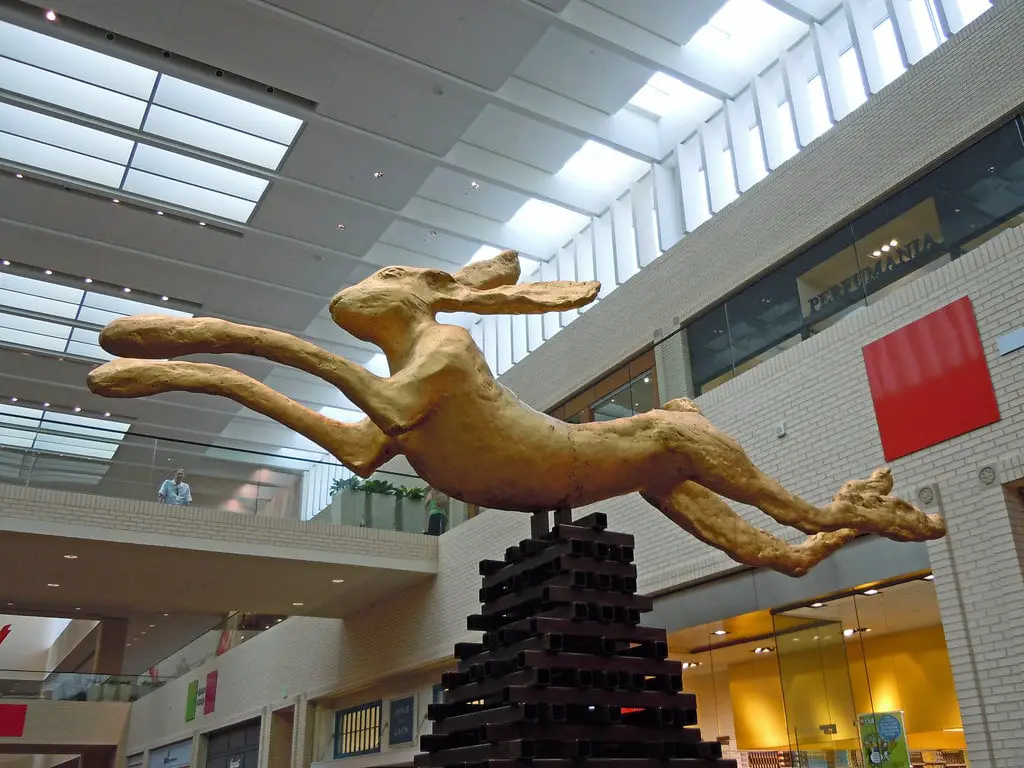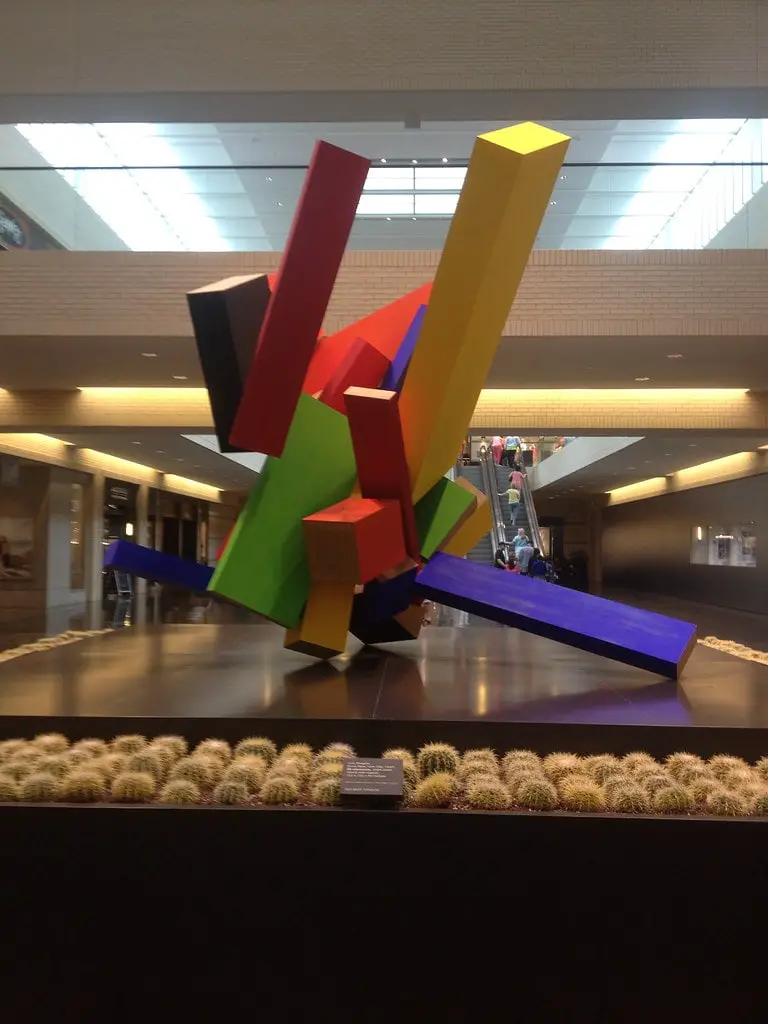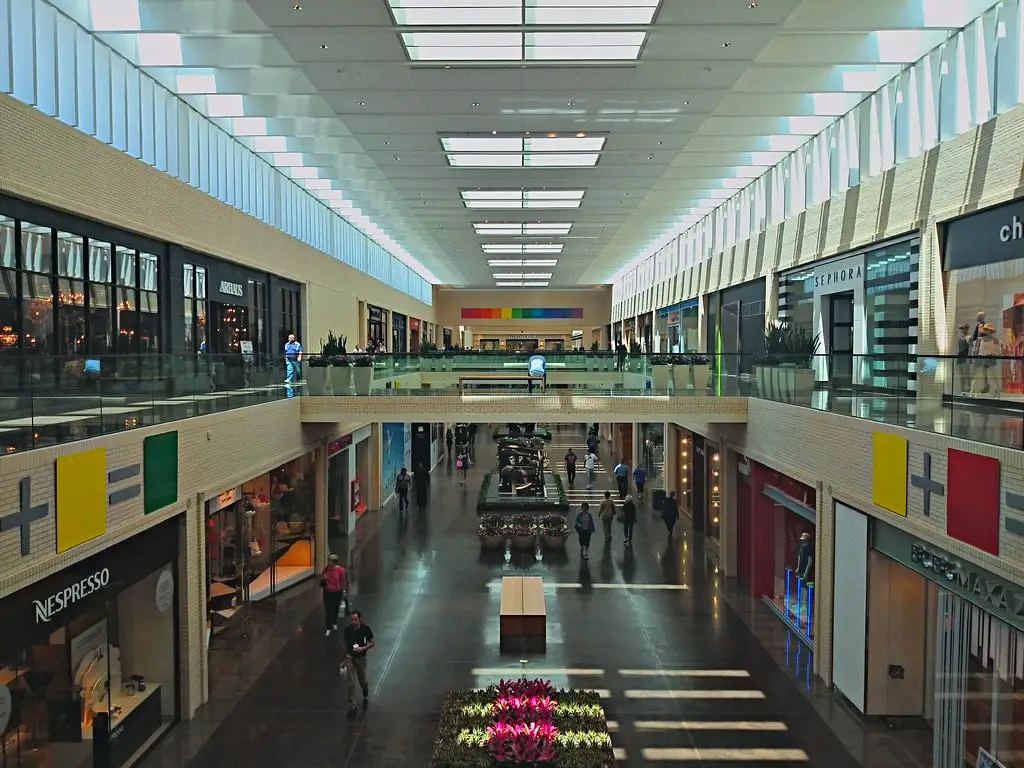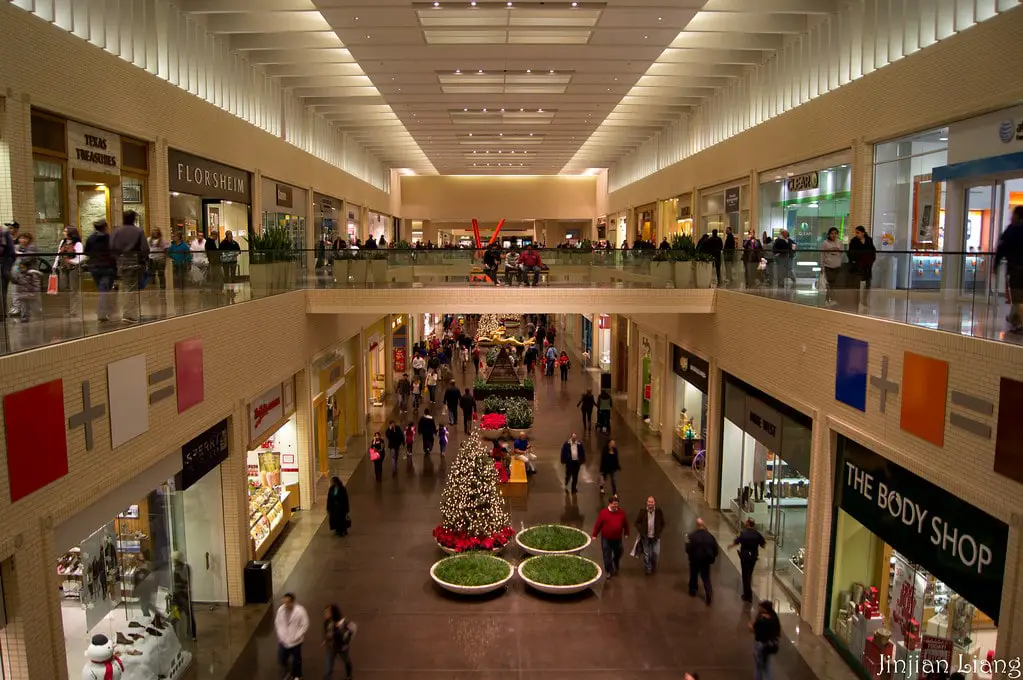Retail Genesis at NorthPark Center: The Foundation of a Shopping Empire
Early Beginnings: A Vision of Modern Retail in Dallas
In the bustling city of Dallas, Texas, a vision for modern retail took shape in the early 1960s. This vision was embodied by NorthPark Center, an enclosed shopping mall that emerged from a 97-acre cotton field.
The transformation of this field into a retail landmark marked the beginning of a new era in Dallas’s commercial history.
NorthPark Center, which opened in 1965, was not just a shopping space but a symbol of the city’s growth and modernization. From its inception, it was destined to become a central point of interest in Dallas, changing the city’s retail landscape.
The Mall’s Initial Anchors and Key Stores
The mall initially boasted a strong lineup of anchor stores, including the prestigious Neiman Marcus, which moved from its previous location at Preston Center.
Alongside Neiman Marcus were Titche-Goettinger and Penneys, offering diverse shopping experiences. Other notable stores at the time of opening included Woolworth’s, Kroger, and Doubleday.
These stores provided various shopping options and established NorthPark Center as a go-to destination for a broad spectrum of consumers in Dallas.
Expansions and Changes Over the Years
NorthPark Center has continually evolved, expanding its horizons and offerings. A significant expansion in 1973 saw the addition of a new wing anchored by Lord & Taylor, enhancing the mall’s appeal.
However, in early 2004, Lord & Taylor was repositioned and shuttered, a change reflecting the evolving retail landscape. The most transformative period for NorthPark Center came in 2006, with an expansion that more than doubled its size.
This expansion was not merely about adding space but enhancing the shopping experience, introducing specialty retail shops and a 15-screen AMC theater.
NorthPark Center Today
In 2023, NorthPark Center is prominently located at the crossroads of Loop 12 (Northwest Highway) and US 75 (North Central Expressway), featuring more than 200 diverse stores and dining options.
Its annual sales exceed $1 billion, making it the 20th-largest shopping mall in the United States. Today, the mall is home to a mix of traditional retailers like Dillard’s, Macy’s, Neiman Marcus, Nordstrom, AMC Theatres, and Eataly, as well as specialty retailers such as UpWest, Arhaus, AllSaints, Aritzia, Psycho Bunny, and more.
This diverse range of stores makes NorthPark Center a key shopping destination and a vibrant part of things to do in Dallas, Texas.
Since its inauguration in 1965, NorthPark Center has expanded to house more than 200 stores and restaurants, achieving annual sales surpassing $1 billion.

Architectural Blueprints for Commercial Success: Designing NorthPark Center’s Space
A Unique Architectural Vision
NorthPark Center’s architectural journey began with the vision of its founder, Raymond Nasher, who sought to create a space that was more than just a shopping center.
He hired E.G Hamilton of Harrell+Hamilton Architects, a choice that set the stage for NorthPark Center’s distinctive design. The architecture of NorthPark Center is a standout feature, blending functionality with aesthetic appeal.
Its design goes beyond the typical layout of a mall, offering an experience that is visually pleasing and shopper-friendly.
This focus on architectural excellence has been a cornerstone of NorthPark Center’s identity since its inception.
The Role of E.G Hamilton and Harrell+Hamilton Architects
E.G Hamilton’s role in designing NorthPark Center was pivotal. His vision was to create a space that was a shopping place and an architectural landmark.
The design, characterized by clean lines and an open layout, was revolutionary and set a new standard for shopping mall design.
This innovative approach to mall architecture has been recognized and appreciated by shoppers and design enthusiasts.
The architectural integrity of NorthPark Center is a testament to the foresight and talent of E.G Hamilton and his team.
Maintaining Aesthetic During Expansions
One of the unique aspects of NorthPark Center is its commitment to maintaining its original aesthetic even as it has expanded over the years.
The 2006 expansion was particularly noteworthy in this regard. The mall brought back Harrell+Hamilton Architects, the firm that designed the original section, ensuring the expansion would respect and enhance the existing architectural style.
This decision highlights the mall’s dedication to preserving its architectural heritage while adapting to modern retail needs. The result is a seamless blend of the old and the new, a rare feat in retail expansions.
The Mall as a Modern Architectural Marvel
Today, NorthPark Center stands as a modern architectural marvel in the heart of Dallas. Its design continues to attract attention for its elegance and innovativeness.
The mall’s layout facilitates a smooth traffic flow, making shopping an enjoyable experience. The blend of classic and contemporary architectural elements makes NorthPark Center a shopping destination and a place of visual and aesthetic interest.
Its architecture inspires and influences modern mall designs, making it a significant landmark in retail architecture.

Marketplace Evolution: Retail Dynamics at NorthPark Center
Introduction of Major Retailers
NorthPark Center has been a beacon for major retail brands, drawing in diverse shoppers since its early days.
The mall welcomed renowned department stores like Macy’s, Dillard’s, Nordstrom, and Neiman Marcus, each with unique style and clientele.
This variety of big-name retailers has been a key factor in NorthPark Center’s success, offering something for every shopper.
From high-end fashion to everyday essentials, these stores have helped shape the mall’s identity as a comprehensive shopping destination in Dallas.
The Impact of New Store Openings
Over the years, NorthPark Center has seen the introduction of various new stores, further diversifying its retail portfolio.
Notable additions include AMC Theatres, providing entertainment options, and Eataly, a food-lover haven. The opening of these stores has expanded the mall’s offerings and enhanced the overall customer experience.
Shoppers can now enjoy a movie, indulge in gourmet food, or explore the latest fashion trends under one roof.
These new stores have contributed significantly to the mall’s reputation as a versatile and dynamic shopping center.
Retail Landscape Changes
The retail landscape at NorthPark Center has witnessed several changes, reflecting consumers’ evolving preferences.
One such change was the closure of Barneys New York in 2012, a store that had been a part of the mall since 2006.
The space previously occupied by Barneys was later repurposed for stores like Arhaus and Eataly, showcasing the mall’s ability to adapt and evolve with changing retail trends.
These shifts highlight NorthPark Center’s commitment to staying relevant and appealing to a broad range of customers.
Current Retail Mix and Shopping Experience
Today, NorthPark Center offers a rich mix of retail options, catering to a wide spectrum of tastes and preferences.
The mall presents an eclectic retail environment, from luxury brands like Balenciaga and Saint Laurent to popular labels like AllSaints and UpWest.
The current retail mix reflects the mall’s history, growth, and forward-looking approach to retail. Shoppers at NorthPark Center can expect a unique and enjoyable shopping experience, surrounded by diverse stores and services that cater to their every need.

Cultural Investments and Community Dividends: NorthPark Center’s Broader Impact
Recognition as a Modern Retail Wonder
NorthPark Center’s influence extends beyond the realm of retail, making a significant impact on culture and community.
In November 2007, this Dallas landmark was celebrated as one of the “seven retail wonders of the modern world.”
This prestigious recognition placed NorthPark Center alongside international retail marvels, highlighting its importance in the United States and the global retail landscape.
This accolade reflects the mall’s exceptional design, diverse retail offerings, and its role as a cultural hub in Dallas.
Hosting the American Film Institute’s Dallas International Film Festival
In 2009, NorthPark Center became the focal point for cinematic art by sponsoring the American Film Institute’s Dallas International Film Festival.
The event was hosted at the AMC NorthPark 15 Theater, reinforcing the mall’s commitment to cultural enrichment.
This sponsorship and hosting of the film festival for several years underlined NorthPark Center’s role in promoting arts and culture far beyond the traditional scope of a shopping mall.
A Center for Fashion and Cultural Initiatives
NorthPark Center is a shopping destination for fashion and cultural initiatives. It became the home of Texas‘ first H&M store, a significant addition that added a new dimension to the mall’s fashion offerings.
Beyond fashion, NorthPark Center engages in various cultural events and initiatives, making it a vibrant part of Dallas’s cultural scene.
These activities reflect the mall’s commitment to being more than just a place for shopping but a place where culture and commerce intertwine.

NorthPark Center: A Star in Television and Film
NorthPark Center’s Debut in Film and Television
NorthPark Center has also played a notable role in television and film. The mall’s distinct interior has provided the backdrop for scenes in various productions, showcasing its versatility and visual appeal.
This aspect of NorthPark Center highlights its cultural significance beyond retail and architecture, positioning it as a recognizable and sought-after location in the entertainment industry.
Memorable Moments in Cinematic History
One of Northpark Center’s most memorable cinematic moments is featured in the Robert Altman film “Dr. T and the Women.”
A scene with the character Kate, portrayed by Farrah Fawcett, takes place around the Neiman Marcus court.
This scene is memorable for Kate’s playful and uninhibited frolic in the Dillard’s court fountain. Such moments capture the unique ambiance of NorthPark Center, lending a distinctive character to the films in which it appears.
“True Stories” and NorthPark Center’s Evolving Ambiance
The 1986 movie “True Stories,” co-starring David Byrne and John Goodman, included a scene of a fashion show set in the fictional town of Virgil, Texas.
This scene, filmed inside NorthPark Center, between Neiman Marcus and Dillard’s, brought a slice of the mall’s interior charm to the silver screen.
The film also included shots of Byrne and Goodman walking down one of the mall’s corridors, further integrating the mall’s aesthetic into the movie’s narrative.
The Mall’s Transformation Over Time
2006, following the mall’s reopening, The Dallas Observer drew comparisons between the current ambiance of NorthPark Center and its portrayal in “True Stories” filmed two decades earlier.
The article highlighted the transformation of NorthPark Center, describing it as a “tricked-out spaceship” compared to its earlier, more austere version.
This comparison underscores the mall’s evolution over the years, not only in terms of its physical structure but also in its atmosphere and vibe.
The exterior shots for Virgil’s mall in “True Stories” were filmed at the former Big Town Mall in Mesquite, contrasting the interior scenes shot at NorthPark Center, illustrating the versatility of the mall as a filming location.
NorthPark Center’s role in television and film underscores its multifaceted nature, serving as a shopping center and a vibrant cultural and cinematic landmark in Dallas.

Retail Renaissance: A Summary of NorthPark Center’s Commercial Journey
As we reflect on the journey of NorthPark Center, it’s clear that this shopping mall is more than just a collection of stores; it’s a landmark that has significantly influenced Dallas’s retail, cultural, and community landscapes.
From its humble beginnings in the 1960s to its current status as one of the largest and most diverse shopping centers in the United States, NorthPark Center has continually evolved, adapting to the changing times while maintaining its unique identity.
The mall’s commitment to architectural excellence, diverse retail offerings, and cultural initiatives have made it a central hub in Dallas. It has provided a space for shopping and entertainment and fostered community engagement and cultural enrichment.
NorthPark Center’s ability to blend commerce with culture and community involvement exemplifies its role as more than just a shopping destination.
Looking to the future, NorthPark Center is well-positioned to continue its legacy of innovation and excellence. As it adapts to new trends and consumer needs, it will undoubtedly remain a key player in the evolving narrative of Dallas.
NorthPark Center’s journey from a local shopping center to a nationally recognized retail and cultural hub is a story of vision, adaptation, and enduring impact.
